 Facebook
Facebook
 X
X
 Instagram
Instagram
 TikTok
TikTok
 Youtube
Youtube
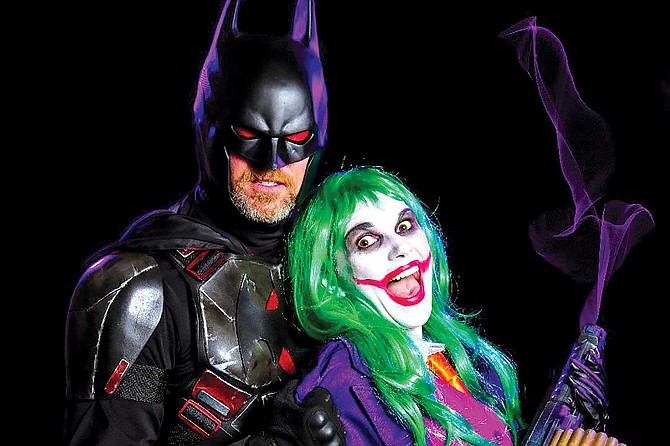
By Jay Allen Sanford
Not long ago, few had ever heard the word “cosplay.” Nowadays, pretty much any pop culture convention will be overflowing with costumed role-players posing for snapshots and giving each other awards. It’s those photos of imaginative cosplayers, portraying both known characters and original creations, which tend to lead Comic-Con coverage, as the players themselves have become actual attractions. Observe the way crowds gather around the more eye-catching costumers. A case can be made (usually by a cosplayer) that they’re the real stars of Comic-Con. Though you’d find ample argument to the contrary from annoyed exhibitors fed up with both aisles and customers being blocked by all the impromptu flexing, posing, and flashing.
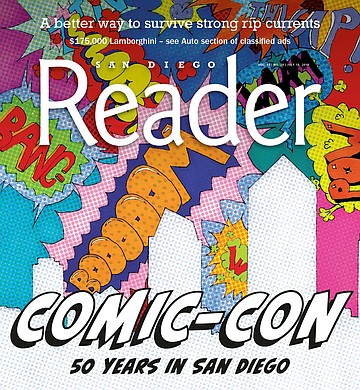
That’s flashing as in flashbulbs, not nudity, although it’s probably no coincidence that the increased media exposure has coincided with increased skin exposure. From humongous Hulks barely contained inside strategically shredded trousers to voluptuous Vampirellas whose modesty hinges on little more than a carefully arranged bathrobe sash, teasing flesh is a Con tradition dating back to the earliest comic-themed gatherings. That is what they wear in the comics, after all. Although no Vampirella comic ever featured a scene where so many men tried to pile into an El Cortez Hotel elevator behind the lone woman rider, fresh from winning a Vampi costume contest, that the elevator got stuck between floors for over an hour. (Legend has it, not a single man complained.)
This year, one contentious topic among cosplayers and Con attendees is the relatively new arrival of Instagram-obsessed costumers who refuse to pose for candid photos unless “tipped,” or who set up a spot on or near the convention site (sometimes paid, sometimes without a legit event pass) where they charge a fee to have their photos taken. Often at a higher rate if you pose with them, akin to the mercenary superhero impersonators known to accost tourists in Times Square.
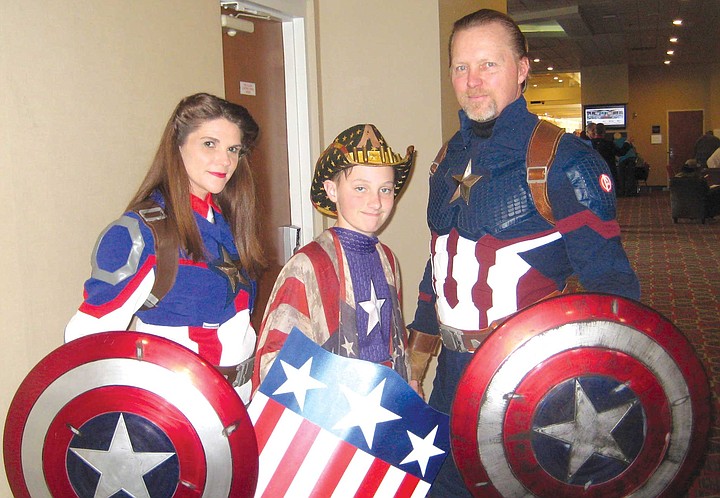
There’s also a growing rift between “competitive” cosplayers, there to win contests, and those just wanting to share their creativity and get a little attention. “First off, you never charge for photos,” says North Park’s Shawn Richter, a 50-year-old service manager who has been cosplaying for around six years. “This isn’t Hollywood Boulevard. I do it for fun, and see it as a way to celebrate the characters that I love. Secondly, cosplay is not a competition, which is why I don’t enter contests. I only cosplay for fun, and for charity.”
Richter, who was once featured on the Inside Edition website proposing to his girlfriend at the premiere of Avengers: Endgame, often dons matching tights alongside his fiancée Lisa Lower. “This will be my eleventh San Diego Comic-Con and her seventh.... We always wear matching costumes, [such as] Batman and Wonder Woman, Captain America and Peggy Carter.”
While some cosplayers prefer to limit their sartorial showcases to the event itself, Richter says, “I love wearing our costumes around downtown during Comic-Con. Mainly, I love running into the little kids who think you actually are the character you’re dressed as.”
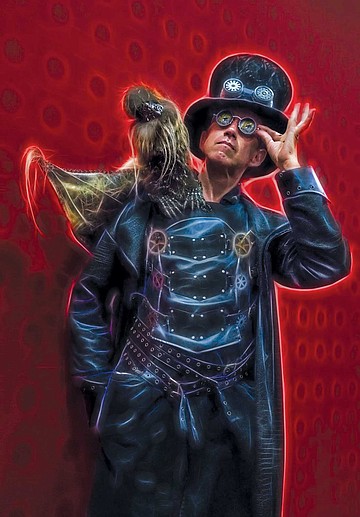
Those well-versed in comic lore will recall how actor George Reeves, while doing a public appearance as Superman, was once reportedly confronted by small child who pointed a loaded gun at him, intending to see if bullets really bounced off his chest. Reeves, the story goes, saved the day by warning that ricochets could hurt an innocent bystander.
“I’ve never felt in danger while out in public in costume,” says 55-year-old cartoonist and chauffeur Dean LeCrone, a familiar face at local cons while dressed as his own steampunk-inspired character Dr. Peepers. “Except for that one time when Thanos arrived in San Diego with the Black Order and the Chitauri army. I peed my pants a little bit.”
“It’s fun to walk across the street into the Gaslamp Quarter and roam 5th Avenue, which is cordoned off to traffic. It’s like Mardi Gras over there during Con…I love the public’s positive reaction to my costumes. Especially Dr. Peepers, as I’m always kind of putting on a show, what with the retractable wings, the robot arm that lights up, and my dragon puppet, which people go nuts for because I make him move and he’s very realistic looking.”
The longtime Oceanside resident says he doesn’t usually enter competitions, but ended up being awarded a trophy anyway. “In 2016, I won the SyFy channel’s Weirdly Awesome Costume Contest and appeared on their Live from Comic-Con television show,” he says. “A camera crew from the SyFy network saw me, and they were desperately seeking cosplayers to interview. So they did some filming of me, and then they informed me of their contest, took photos of me, and nominated me for it, and said that people could vote all week during Con.”
As for charging for pictures, “Unless a cosplayer has actually spent money on a booth in the exhibit hall and is selling poster prints of themselves and other wares or art related to their cosplay persona, and promoting themselves within a booth setting, then no, I don’t believe it is reasonable to charge for photos in a Comic-Con setting.”
What would he say to such a profiteering cosplayer? “I would just roll my eyes and groan. I might even say ‘Geez, really? Who do you think you are? Are you really that full of yourself?’ And then I might announce to anyone standing there waiting to pay for a photo, ‘Hey, there are hundreds of cosplayers here today who are not charging for photos. Follow me!’”
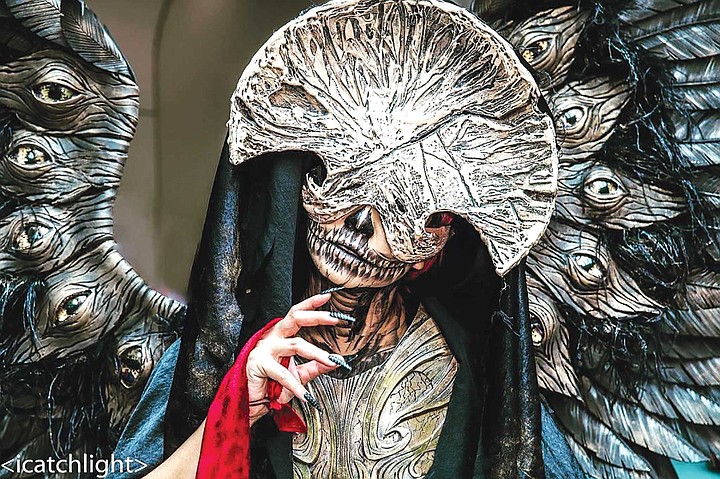
“I have heard people get upset when I don’t stop for a photo, but sometimes it just takes forever to get to that bathroom,” says 37-year-old architectural designer Linda KimChi Nguyen, aka KimChi Cosplay, whose elaborate constructions can slow her progress through any room. “I’m never alone, as I usually need someone there to help me anyways, since my costumes have so many pieces.”
Based in Normal Heights, she’s been cosplaying for around ten years. “San Diego Comic-Con is always the first place I display my costumes,” she says, citing Death Angel from Hellboy 2: The Golden Army (2008) and the title character from Maleficent (2014) as her favorite creations. “My Maleficent costume probably cost me around $500, but didn’t cost me as much as my Wonder Woman cosplay, because I made the shield from scratch, had to buy power tools and everything, and this was long before the movie came out.”
She tries to limit her appearances to the event itself. “Honestly, I didn’t start wearing costumes and going to Comic-Con just so I could be stuck outside [laughs]. I know that’s where a lot of people take photos of cosplayers… I only wear my costume when I’m making the walk to and from my car, or trolley to the convention center.
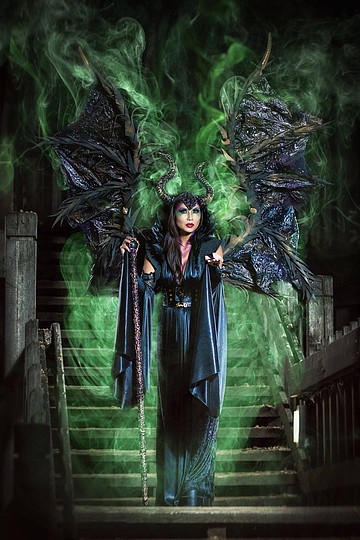
“My biggest crowd stopper was Maleficent, because I made huge wings, which pretty much stopped traffic. I think that same year, Stephen Colbert was dressed up as Hawk Cat, and he kept following me. But I had no idea who he was until a friend of mine said he saw me on the Late Show.”
Nguyen doesn’t think cosplayers should charge for photos, and also warns against taking a method acting approach to roleplay. “Comic conventions get people so hyped up. They are dressed up as characters, and it’s a strange transformation. Some people, they really take on their character.”
This can be a problem, given how many contemporary comic characters are complete jerks (I’m looking at you Deadpool, Punisher, Strange, Stark, Wayne, Arrow, Cage, Phoenix, Rorschach, Joker, Rocket Raccoon, etc).
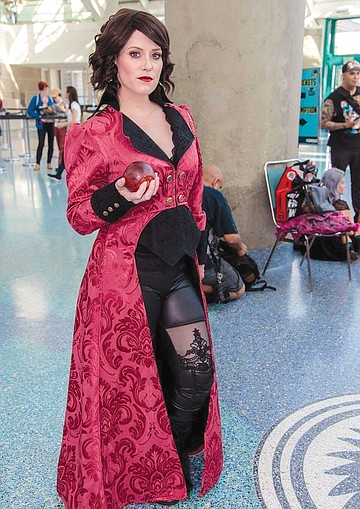
“I do not charge for photos, and I do not know anyone who charges for photos, unless they have a booth of their own,” says Poppy Appleton, who has been cosplaying for around ten years. “I think the best way to avoid friction is to recognize when you might be taking up too much space or unintentionally blocking someone’s booth or a large part of an aisle.”
The 38-year-old UTC resident says costumed Con attendees should also be mindful of safety, especially after incidents such an alleged off-site attack on a local 17-year-old female cosplayer. “I have heard of other cosplayers who have been cornered, had their props or costumes damaged, or even assaulted… I’ve had people make comments, usually by people who don’t know what’s going on. I have never personally felt in danger, but my husband wears stilts. We were walking at an event in Old Town Sacramento and a drunk man came out from a bar and grabbed one of his stilts as he was walking by. I may have body checked him back into the bar when my husband nearly fell.”
This year’s Comic-Con will be Appleton’s fourth time attending, and her third as a cosplayer. “I have plans to wear a few comfortable, simple costumes for two of the days at the Con, Kim Possible and Captain Marvel.” She says the hardest to assemble was the Evil Queen from the Once Upon A Time TV series. “It was so difficult for me, because I do not sew regularly, I’m more of a prop maker…. The costume cost me a little over $200, because I used upholstery fabric for the cloak. I also had to purchase boots — Goodwill — a wig, jewelry, and accessories for the costume, and accompanying makeup. It took me probably two months to sew the cloak, because some nights I could only sew for maybe 30 minutes at a time due to my work schedule.”
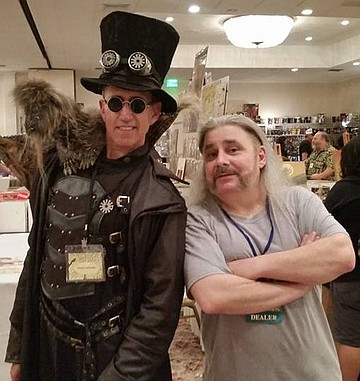
Dean LeCrone's signature Peepers costume has cost much more than $200, but that's over a number of Comic-Cons. “The character had sort of a western look in the beginning, but over the years he has morphed into what it is today, sort of steampunk gothic meets Van Helsing. I've added gears and gadgets, a black trench coat, 'Demonica' boots, a robot arm, retractable wings, and an incredible realistic looking dragon puppet that sits on my shoulder that I manipulate with slight of hand under my trench coat. If you add up every item I just mentioned, it comes to about $1300.”
Linda Nguyen points out that one doesn’t need to lose sleep OR spend money to enjoy convention cosplay. “Just go to San Diego Comic-Con, even if you don’t have a ticket. So many, or maybe most, cosplayers are outside the convention center without a ticket. Tons of photographers are out there, because there’s room to shoot.”
For aspiring costumers seeking a deeper purpose behind donning their disguises than transforming the streets of downtown San Diego into an anthropomorphic fever dream right out of Roger Rabbit’s Toontown, Nguyen suggests, “There’s a lot of hospitals that get cosplayers to visit the kids to cheer them up. I would say that’s a great place to start. It gives people a whole different reason to cosplay.”

By Mike Madriaga
Every year about this time, Vinnie Wood wonders if he’ll be able to attend Comic-Con International: San Diego. He’s been attending since 1980.
“I never met another homeless comic book fan,” he said on June 10, “until I met one of my best friends, [Peter S.], who took me in his home for awhile. He’s a fellow comic book and sci-fi fan — and was also once homeless.”
Wood lives out of his car, storage unit, and his buddies’ homes. He’s been off-and-on homeless since 2000, which is about the same time that he noticed Comic-Con starting to become a pop culture phenomenon that now draws over 130,000 fans from all over the world.
“Around the early 2000s,” Wood recalls, “it seemed like it commercialized, and big studios started coming in and taking up room from small vendors. And dramatic price increases, too.”
Of late, it’s become increasingly difficult for professionals (comic book writers and artists), media, talent, volunteers, cosplayers, and lifelong Comic-Con fanatics such as Wood to obtain passes to enter the four-to-five day convention that spills out from the 2.6 million-square-foot San Diego Convention Center.
“It’s so hard to buy passes online,” Wood said. “I tried at least six times with no luck. So basically, now you have to know somebody like a dealer on the inside to get in.”
William Messner-Loebs had VIP access to Comic-Con in 2017 when he co-won the Bill Finger Award with the late Jack Kirby for excellence in comic book writing.
Like Wood, Messner-Loebs and his wife Nadine are homeless — but in Michigan.
I spoke to Messner-Loebs on the phone on June 19. He was test driving his Chrysler, which had been in the shop for three weeks. He was hoping it would last throughout 2019, because he’s already used up his yearly tow allotment with AAA.
“We’re not living in our car [anymore],” he said, “we live in the one hotel where the... social services organization helps us. It’s the only place that exists where the ‘down and out’ can go.”
Messner-Loebs, 70, and Nadine, 81, have been homeless since 2001.
“Now we have air conditioning,” he said, “which is good for right now, because its getting into the 90s here in Michigan. And when it gets cold, we have heat.”
To sustain himself and his wife, Messner-Loebs currently works at Panera Bread as a delivery driver and on the side he makes guest appearances at comic book shows to talk about and sign the old comic books that he wrote, penciled, or inked — including Wonder Woman, The Flash, Thor, Batman, and The Maxx.
Back in San Diego, Wood and Peter buy and sell collectibles online when they can locate a wifi signal. In 2015, I purchased Spider-Man and Venom basketball jerseys from the pair, after I saw their eBay auctions.

Peter sold the same style jerseys that I purchased for $12 at the Con, where he’s been a vendor since the early 1990s. “We sold them for $25 at the show,” Peter recalled.
I wore the Spidey jersey to last year’s Con.
“So you’re Wood’s connect to get inside the comic convention?” I asked.
“Yeah, Vinnie [Wood] helps us inside the Con by watching our stuff; he gets us food and drinks; and he helps to set up and break down our booth display,” Peter explained
Peter compensates Wood’s labor with a bona fide Comic-Con International dealer badge. A dealer badge can sell on the black market for $1000, because it grants 1-2 hours of access inside the show before the general public enters, and for another hour after the show shuts down for the night. You can wander about the venue, shop and take selfies — without anybody in the way.
“I once saw Rosario Dawson (the actress who plays Claire Temple on the Marvel Comics/Netflix collabs) in the exhibition hall,” Wood said, “and the cast for Breaking Bad and Spartacus in Hall H.”
The Con reminds Wood of his “childhood, which was good because my parents were supportive of my collecting and were happy to see me reading all the time,” he said.
Peter recalled when he purchased about 175 comic books from Wood in 1982, including “the first appearance of Punisher” (Amazing Spider Man #129), and the death of Gwen Stacy and Green Goblin as well” (Amazing Spider Man #121).
These days, on the Comic Link website, Spidey #129 is listed for over $12,000 and Spidey #121 is over $4000.
“I paid about $2 a book,” Peter recalled, “except for the first appearance of The Punisher. For that, I paid $40.”
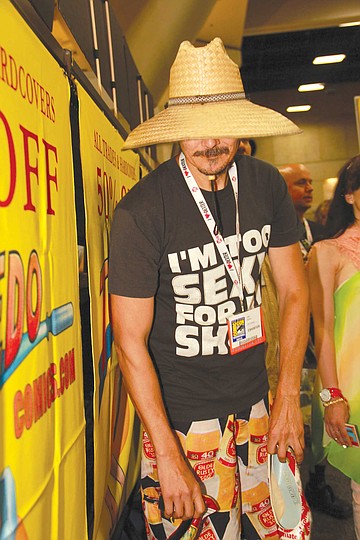
Around the same time, Wood had other key issue comic books that he didn’t sell to Peter.
“I had some high-grade Golden Age and Silver Age, including a grade 7.5 Superman #2, and some Marvels, including a Spider-Man #1, Amazing Fantasy #15, Journey Into Mystery #83 — all in high grade, which is the only grade I collect. Grade 7.0 minimum.”
(A grade 10 specimen comic book — which is extremely rare — is flawless inside and out.)
“Do you still have those issues?” I asked.
Wood paused.
“They were stolen when my house was broken into,” he said, “by someone who knew that I had them.”
“His collection, which was in a suitcase, was stolen from his old house on Glading Drive,” Peter recalled, “not too far from here” (in south San Diego).
An online search shows Amazing Spider-Man #1 in grade 8.5 condition is selling for $75,000; an Amazing Fantasy #15 in grade 7.5 condition is selling for $225,000; and a Journey Into Mystery #83 in a grade 9 condition is up for $108,000.
“His Superman 2 in grade 7 condition sells now for $50,000,” Peter added.
“It’s very painful to think about,” Wood says. “Luckily I had home insurance and got $10,000 which I did not reinvest because of the birth of my son around 1984-1985.”
This was about the same time that Messner-Loebs wrote and illustrated Journey: The Adventures of Wolverine MacAlistaire. In 1985 or 1986, he and Nadine flew out to the San Diego to attend the Comic-Con for his nomination for the Russ Manning Most Promising Newcomer Award; he did not win. In 1987, the couple flew back to the Con for another nomination, and this time Messner-Loebs won the Inkpot Award for contributions to comics, animation, science fiction, and popular culture.
“For two years, I was floated by DC Comics to fly out to San Diego, because I was writing for Wonder Woman,” Messner-Loebs said. “I was making good money between writing five books and then The Maxx.… At those times you were still in touch, with the real publishers and editors and the artists and writers, because we were in their booths.”
In the ‘80s-’90s, he wrote Wonder Woman issues #63 to #100.
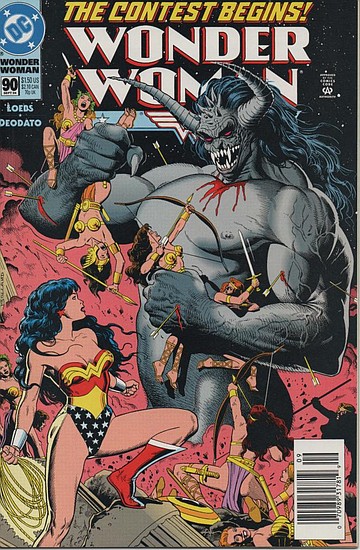
“Messner-Loebs created a character named Artemis of Bana-Mighdall in Wonder Woman issue #90,” Peter recalled. “Artemis recently became popular.”
Peter continued, “(Messner-Loebs) only has one arm, which didn’t stop him from being a legendary storyteller and artist — he’s a real superhero to all of us.”
Like Wood, Messner-Loebs and his wife Nadine became homeless right around the turn of the century.
“The bottom fell out of the comic book industry in ‘98-’99,” Messner-Loebs said.
Peter remembered why. “The comic prices were too high for the norm — $2.95 was expensive for a 1990s comic book, especially when we were used to paying $1.25 - $1.50 per comic, and then after 1994, they glamorized comic books with too much shiny stuff like foil covers and prism covers, and those gimmicky covers were $4.95.
“What really hurt the comic book industry was the new-at-the-time [method of] browsing and reading stuff on the worldwide web — and it was free. But they rebirthed DC and Marvel in 2002-2003 and started everything from scratch again.”
Throughout the 2000s, Messner-Loebs and Nadine did not return to the annual San Diego comic convention.
“Once we started getting into financial difficulties,” he said, “going across the country was one of the first things we dropped when we ran out of money. My wife had open heart surgery a couple of years ago and cataract surgery, plus therapy on her knees so she can continue to walk at all,” he says in part on his Gofundme campaign. “She is in constant pain. Past, present, and future medical bills loom pretty large. I’ve been working as a delivery person for Panera Bread and as a fill-in janitor for my local church plus doing sketches and covers at local conventions. Those things, plus Social Security, kept our heads above water.”
In 2017, the couple’s homeless situation didn’t change for the better — although Messner-Loebs’ recognition did when he was listed in the credits for the 2017 Wonder Woman movie.
“Nadine was hitting me in the side,” he said. “She had sunk her nails into my arm and was jumping up and down screaming, ‘Look there, look there. It’s you on the screen.’”
The month after the Wonder Woman movie hit the silver screen, Messner-Loebs and Nadine were flown out to the Con for his Bill Finger Award.
“I loved getting the award,” he said, “and I loved that my co-award winner was Jack Kirby, and I got to meet everybody there.”
“Congrats for that, it’s well deserved,” I commented. “Will you be returning in July of 2019?” I asked.
“I would never go to the San Diego Comic-Con again unless I was being paid to do it,” he responded. “I was horrified at how difficult it was to go to the Comic-Con. It was completely packed. You were traveling at about two miles an hour anywhere you were. From our hotel, which was two blocks away, getting to the convention center took about an hour. I know this makes me sound like an old fogey, but I go to busy conventions around here (in the Midwest) — and this was a totally different animal.
“And the networking possibilities?” I asked.
“They no longer have any real publishers at San Diego,” he responded, “certainly no one from Marvel or DC. They are all publicity people who can’t answer any of those [editorial] questions. They were all PR people, and there was nobody from editorial anywhere. I was hoping to get contacts, and I was hoping that I would talk to people; but it was impossible to do.”
“What’s happening next?” I asked.
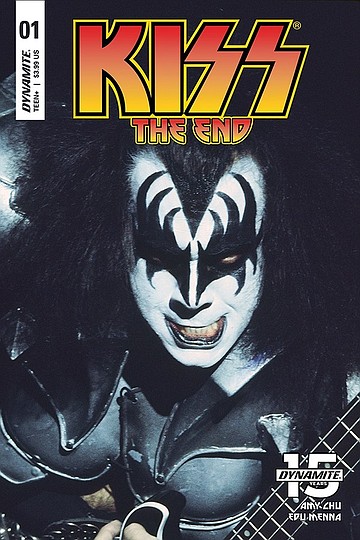
“I’m assisting [with comic book writer Amy Chu and Edu Menna] with a KISS comic book,” he said. “It’s a celebration of this long final tour that they are doing, using the medium of a science fiction background. We have a KISS fan who has been thrown into the mission of recovering a mystical sword that KISS, the band, has picked up sort of inadvertently.”
Peter and Wood remember seeing KISS’s Gene Simmons (sans makeup) roaming the Con’s halls. For July, Peter is seeking vintage KISS toys and the Wonder Woman #90 issue that Messner-Loebs wrote — the one with the first appearance of the Artemis character — to sell at his booth. “The [Wonder Woman #90] comics were like $20-$30 last year, and now they are $100 apiece,” Peter said.
“I’ve heard through the grapevine that there’s a possibility somewhere down the line, if they do a second Wonder Woman movie,” Messner-Loebs said, “that the movie might have Artemis in it.”
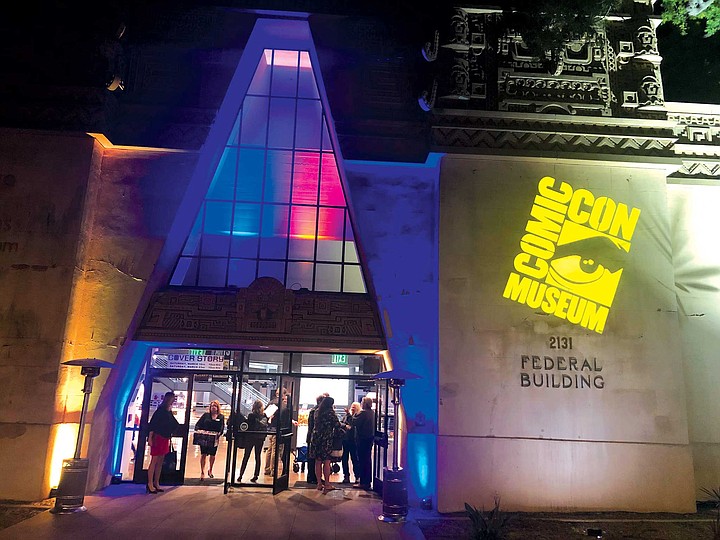
Matthew Lickona
“Plato’s Academy and Aristotle’s Lyceum had musaea in them, with statues of gods, where lectures took place. But of course the Musaeum in Alexandria was literally a temple to the muses, a shrine to the muses, with [the near-mythical, super-stocked, and tragically burned] library attached. Initially, it was a place where scholars gathered, where research was done. It was meant to be a place to inspire active, new, creative thought. It’s almost like we’re coming back to that notion of museums: that they’re not just there to collect and display a collection of cultural artifacts, but to promote debate.”
— Angie Hobbs, Professor of the Public Understanding of Philosophy at the University of Sheffield, speaking on the BBC program In Our Time for an episode devoted to the Muses, the divine beings behind that inspiration of “new, creative thought.”
Hearing that made me wish I could invite Professor Hobbs to The Gathering, Wednesday night’s gala fundraiser for the nascent Comic-Con Museum in Balboa Park. The Museum proper is scheduled to be completed in 2021 — thanks in no small part to several million dollars from the city for repairs to the building, which once housed the park’s Sports Museum — but Executive Director Adam Smith did not want to let the Con’s 50th anniversary pass without marking the occasion in the space that will one day serve as a year-round, permanent expression of its mission. So Smith and his team put together a pop-up version of the cultural center he intends the Museum to become, housed within its own cavernous shell, and open to the public — free of charge, no badge required.
“It’s a way of testing a lot of our ideas,” says Smith. One big one: “Part of the project has always been broadening access to Comic-Con. Here, we’re saying to San Diego, ‘Come on down; get a sense of what the Con is.’” For instance, “The Her Universe Fashion Show of Geek Couture has become extremely popular over the last five or six years, and we’ll have a display of about 20 of the previous winners.” (Last year’s Singer Sewing winner, Jane Burson, created an ensemble based on Howl’s crow transformation in the animated classic Howl’s Moving Castle, and won the chance to help design an Avengers: Endgame-based collection for Hot Topic.)
But while spectacle is certainly key to the Con’s appeal, and while some muse surely visited Ms. Burson as she set out to capture the unsettling not-yetness of Howl’s feathered becoming, it’s Smith’s effort to replicate Comic-Con’s panel programming that puts me in mind of Professor Hobbs and her notion of “museum as scholastic hotspot.” Thursday, Friday, and Saturday will see four panels a day in the Museum’s theater — “repeats of panels that took place at the Convention Center.” They include discussions of the rule of law in the Marvel Cinematic Universe (is Thanos a war criminal?), the science of the Acme product catalogue (does Wile E. Coyote deserve a refund?), the psychology of the Potterverse (what is the relation of personality to Patronus?), and the phenomenon of the “aberrant smartypants” (the cinematic mad scientist as “a modern reimagining of the Faustian idea that knowledge of some universal truths comes at the price of sanity”). I would have enjoyed getting her take on the talks — something in that notion of “public understanding” in her title echoes the Con’s emphasis on celebrating “the popular arts.”
What’s really fun — and this is why I wish Hobbs could attend the opening night Gathering — is the part about how the original Musaeum was a temple, presided over by a priest. Because like Alexandria, San Diego’s Comic-Con Museum will have its statues of the gods: The Superhero Hall of Fame. Smith notes that the Con devotes considerable energy to honoring the people who bring us pop culture, but grants that “for the fans, their deepest love is often for the character.” The museum’s Hall is where they will be able to come and pay homage. And when the Hall makes its inaugural induction during the festivities, there will be a priest of sorts to preside over the ceremony: The Boy Who Loved Batman.
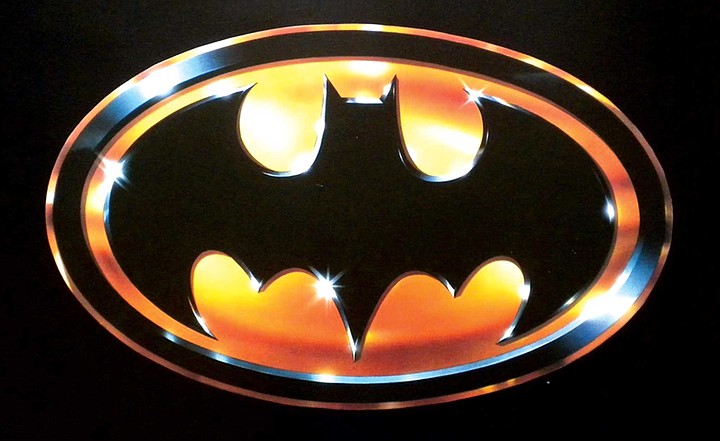
“We’re going to bring in a lot of different dimensions from the Batman universe,” says Smith. “We’ll have material from the Warner Brothers archives: a couple of Batmobiles, costumes from the films. We’ll have Batman comics, Batman-themed art, and a sort of Batcave experience.” There’s a wealth of material out there, which is part of the reason why the Caped Crusader was an easy choice for Hero #1. Plus, it’s his 80th anniversary. Plus, he’s known worldwide. (“I was in Europe on vacation recently,” says Smith, “and maybe it’s because I’ve been thinking about Batman, but it was remarkable how I saw the bat symbol everywhere: London, Paris, Amsterdam…”) Plus, he shows up all over the popular arts: comic books, animation, television, video games, and oh yes, movies. As it happens, 2019 is also the 30th anniversary of 1989’s Batman, itself the result of a 30-year quest to bring The Dark Knight to the big screen, a quest undertaken by the aforementioned Boy: writer/producer/lifelong superfan Michael Uslan.
If calling Uslan a sort of priest seems a bit much, consider his own take: “I believe — and I know that Stan Lee believed — that [superhero lore] has become our modern-day mythology. When I proposed the world’s first college-accredited course on comic books as folklore as an undergraduate at Indiana in 1972, I said that the gods of ancient Greece, Rome, and Egypt still exist, except today, they wear spandex and capes. The Greeks called him Hermes; the Romans called him Mercury; I call him The Flash.”
Uslan’s folklore professor, Dr. Henry Glassie, found himself agreeing that superheroes were “simply an extension of the folklore tradition of great heroes giving people hope as they fight the dragons of their day,” a la Beowulf, and let him take his idea to the dean. (Uslan got the gig.)
If one of the marks of folklore is that it changes along with the folk, then Uslan is ready with the case that Batman fits the bill. “Stan Lee often told me that the greatest and most long-lasting super heroes are the ones with the greatest super villains, because the villains” — the dragons of their day — “define the hero. Batman began in 1939; it was an era of colorful gangsters. During World War II, you saw him fighting fifth columnist spies in America, fighting Nazis who infiltrated our shores. In the ‘50s, you had satellites and the beginnings of the space race, and Batman was fighting aliens. By the 1960s, the world had gone pop, and you had the Batman TV series, with the villains and the stories going over the top. During the ‘70s, the darkness crept in again. Then Frank Miller introduced The Dark Knight Returns in the ‘80s, during the era of Ronald Reagan conservatism. You had an older, more bitter version of Batman, more and more defining in his own mind what law and order meant.” Cue Uslan and director Tim Burton’s effort to take Bats back to his roots as the World’s Greatest Detective.
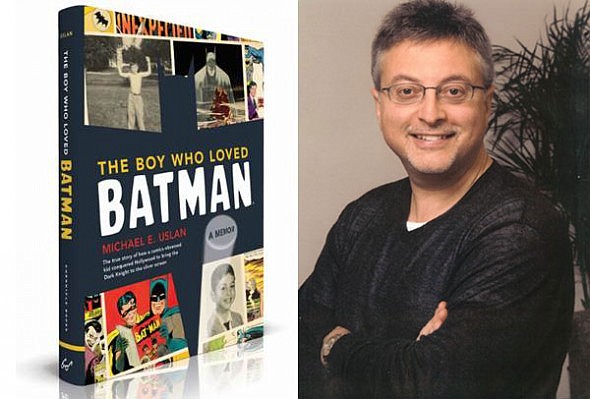
(Uslan’s memoir The Boy Who Loved Batman was published in 2011, and includes a proposal for a story in which Batman loses his place among the one percent after a villain figures out that he relies on Wayne Enterprises tech and manages to bankrupt Bruce Wayne. “The Batman is reduced to the very basics Bruce Wayne started out with,” writes Uslan, “his brains, his detective skills, and his fists…I think readers everywhere hit by the recession will empathize with this stripped-down version of a very real, very human Batman.” Given the success of 2012’s The Dark Knight Rises and its Bankrupt Bruce Wayne storyline, it seems Uslan knows his folk. Today, he laments the rise of Batman “encased in armor like Iron Man,” but can’t help saying he’s “absolutely thrilled with the direction that Matt Reeves is taking with The Batman,” due 2021. Sing, muse!)
And if the jump from folklore to mythology seems a bit like leaping over a tall building in a single bound, consider this, again from Uslan’s memoir: in 2009, he was asked to address the cadets of West Point, who had selected Batman as the recipient of the Cadet’s Choice Award for representing “the code of honor and leadership at West Point.”
Here is Uslan’s brief acceptance speech: “Cadets of West Point, when Bruce Wayne was a boy, he witnessed his parents murdered in the streets before his eyes. On that concrete altar of blood, in the belief that one person can make a difference, he sacrificed his childhood and made a life commitment to get the guy who did this and to get all the bad guys, even if it meant having to march through hell in order to honor that commitment. In doing so, he became a leader, an urban warrior. Cadets of West Point, YOU are Batman!” A little later, one cadet’s mother wrote to inform him that “apparently, they are all walking around now saying, ‘I AM Batman,’ or, ‘You ARE Batman’ to each other.”
Uslan will be “right in the thick of it” at the Gathering, and not just because of Batman. “We have got to maintain an official record of this,” he says, “while there are still those of us around who knew, first hand, the creators, artists, writers, and editors from the 1930s through today. People who can get these stories down accurately: how the industry developed, and how these characters developed. Batman was directly inspired by the hero The Shadow from the pulp magazines; the first Batman story was lifted nearly verbatim from a November 1936 Shadow story called ‘Partners of Peril.’”
If you’re looking for something a little less larcenous, the memoir also includes a letter to young Uslan from C.C. Beck, co-creator and artist for Captain Marvel (perhaps better known as Shazam, thanks to this year’s DC feature), differentiating Billy Batson’s alter ego from Clark Kent’s.
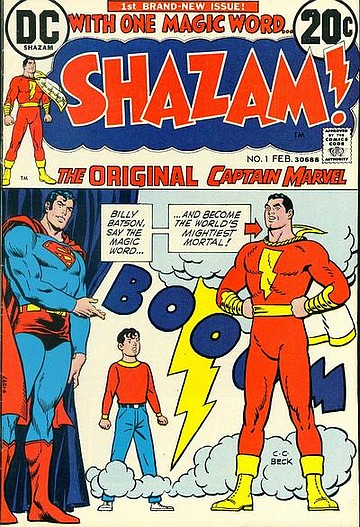
“Captain Marvel was just a big kid who got pressured into all sorts of situations from which the only escape was to fight, punch, and if necessary fly his way out. What was essential was the fact that he did it all by magic, not by being an extraterrestrial character. He got all his traits from mythology, not from Nietzschean theories about supermen. He was our answer to the Nazi philosophy that was sweeping the world. An overgrown kid facing impossible situations. NEVER a superman. Hitler and Goering were supermen. Captain Marvel was just a big, stupid American kid.”
Paging Dr. Hobbs!


By Jay Allen Sanford
Not long ago, few had ever heard the word “cosplay.” Nowadays, pretty much any pop culture convention will be overflowing with costumed role-players posing for snapshots and giving each other awards. It’s those photos of imaginative cosplayers, portraying both known characters and original creations, which tend to lead Comic-Con coverage, as the players themselves have become actual attractions. Observe the way crowds gather around the more eye-catching costumers. A case can be made (usually by a cosplayer) that they’re the real stars of Comic-Con. Though you’d find ample argument to the contrary from annoyed exhibitors fed up with both aisles and customers being blocked by all the impromptu flexing, posing, and flashing.

That’s flashing as in flashbulbs, not nudity, although it’s probably no coincidence that the increased media exposure has coincided with increased skin exposure. From humongous Hulks barely contained inside strategically shredded trousers to voluptuous Vampirellas whose modesty hinges on little more than a carefully arranged bathrobe sash, teasing flesh is a Con tradition dating back to the earliest comic-themed gatherings. That is what they wear in the comics, after all. Although no Vampirella comic ever featured a scene where so many men tried to pile into an El Cortez Hotel elevator behind the lone woman rider, fresh from winning a Vampi costume contest, that the elevator got stuck between floors for over an hour. (Legend has it, not a single man complained.)
This year, one contentious topic among cosplayers and Con attendees is the relatively new arrival of Instagram-obsessed costumers who refuse to pose for candid photos unless “tipped,” or who set up a spot on or near the convention site (sometimes paid, sometimes without a legit event pass) where they charge a fee to have their photos taken. Often at a higher rate if you pose with them, akin to the mercenary superhero impersonators known to accost tourists in Times Square.

There’s also a growing rift between “competitive” cosplayers, there to win contests, and those just wanting to share their creativity and get a little attention. “First off, you never charge for photos,” says North Park’s Shawn Richter, a 50-year-old service manager who has been cosplaying for around six years. “This isn’t Hollywood Boulevard. I do it for fun, and see it as a way to celebrate the characters that I love. Secondly, cosplay is not a competition, which is why I don’t enter contests. I only cosplay for fun, and for charity.”
Richter, who was once featured on the Inside Edition website proposing to his girlfriend at the premiere of Avengers: Endgame, often dons matching tights alongside his fiancée Lisa Lower. “This will be my eleventh San Diego Comic-Con and her seventh.... We always wear matching costumes, [such as] Batman and Wonder Woman, Captain America and Peggy Carter.”
While some cosplayers prefer to limit their sartorial showcases to the event itself, Richter says, “I love wearing our costumes around downtown during Comic-Con. Mainly, I love running into the little kids who think you actually are the character you’re dressed as.”

Those well-versed in comic lore will recall how actor George Reeves, while doing a public appearance as Superman, was once reportedly confronted by small child who pointed a loaded gun at him, intending to see if bullets really bounced off his chest. Reeves, the story goes, saved the day by warning that ricochets could hurt an innocent bystander.
“I’ve never felt in danger while out in public in costume,” says 55-year-old cartoonist and chauffeur Dean LeCrone, a familiar face at local cons while dressed as his own steampunk-inspired character Dr. Peepers. “Except for that one time when Thanos arrived in San Diego with the Black Order and the Chitauri army. I peed my pants a little bit.”
“It’s fun to walk across the street into the Gaslamp Quarter and roam 5th Avenue, which is cordoned off to traffic. It’s like Mardi Gras over there during Con…I love the public’s positive reaction to my costumes. Especially Dr. Peepers, as I’m always kind of putting on a show, what with the retractable wings, the robot arm that lights up, and my dragon puppet, which people go nuts for because I make him move and he’s very realistic looking.”
The longtime Oceanside resident says he doesn’t usually enter competitions, but ended up being awarded a trophy anyway. “In 2016, I won the SyFy channel’s Weirdly Awesome Costume Contest and appeared on their Live from Comic-Con television show,” he says. “A camera crew from the SyFy network saw me, and they were desperately seeking cosplayers to interview. So they did some filming of me, and then they informed me of their contest, took photos of me, and nominated me for it, and said that people could vote all week during Con.”
As for charging for pictures, “Unless a cosplayer has actually spent money on a booth in the exhibit hall and is selling poster prints of themselves and other wares or art related to their cosplay persona, and promoting themselves within a booth setting, then no, I don’t believe it is reasonable to charge for photos in a Comic-Con setting.”
What would he say to such a profiteering cosplayer? “I would just roll my eyes and groan. I might even say ‘Geez, really? Who do you think you are? Are you really that full of yourself?’ And then I might announce to anyone standing there waiting to pay for a photo, ‘Hey, there are hundreds of cosplayers here today who are not charging for photos. Follow me!’”

“I have heard people get upset when I don’t stop for a photo, but sometimes it just takes forever to get to that bathroom,” says 37-year-old architectural designer Linda KimChi Nguyen, aka KimChi Cosplay, whose elaborate constructions can slow her progress through any room. “I’m never alone, as I usually need someone there to help me anyways, since my costumes have so many pieces.”
Based in Normal Heights, she’s been cosplaying for around ten years. “San Diego Comic-Con is always the first place I display my costumes,” she says, citing Death Angel from Hellboy 2: The Golden Army (2008) and the title character from Maleficent (2014) as her favorite creations. “My Maleficent costume probably cost me around $500, but didn’t cost me as much as my Wonder Woman cosplay, because I made the shield from scratch, had to buy power tools and everything, and this was long before the movie came out.”
She tries to limit her appearances to the event itself. “Honestly, I didn’t start wearing costumes and going to Comic-Con just so I could be stuck outside [laughs]. I know that’s where a lot of people take photos of cosplayers… I only wear my costume when I’m making the walk to and from my car, or trolley to the convention center.

“My biggest crowd stopper was Maleficent, because I made huge wings, which pretty much stopped traffic. I think that same year, Stephen Colbert was dressed up as Hawk Cat, and he kept following me. But I had no idea who he was until a friend of mine said he saw me on the Late Show.”
Nguyen doesn’t think cosplayers should charge for photos, and also warns against taking a method acting approach to roleplay. “Comic conventions get people so hyped up. They are dressed up as characters, and it’s a strange transformation. Some people, they really take on their character.”
This can be a problem, given how many contemporary comic characters are complete jerks (I’m looking at you Deadpool, Punisher, Strange, Stark, Wayne, Arrow, Cage, Phoenix, Rorschach, Joker, Rocket Raccoon, etc).

“I do not charge for photos, and I do not know anyone who charges for photos, unless they have a booth of their own,” says Poppy Appleton, who has been cosplaying for around ten years. “I think the best way to avoid friction is to recognize when you might be taking up too much space or unintentionally blocking someone’s booth or a large part of an aisle.”
The 38-year-old UTC resident says costumed Con attendees should also be mindful of safety, especially after incidents such an alleged off-site attack on a local 17-year-old female cosplayer. “I have heard of other cosplayers who have been cornered, had their props or costumes damaged, or even assaulted… I’ve had people make comments, usually by people who don’t know what’s going on. I have never personally felt in danger, but my husband wears stilts. We were walking at an event in Old Town Sacramento and a drunk man came out from a bar and grabbed one of his stilts as he was walking by. I may have body checked him back into the bar when my husband nearly fell.”
This year’s Comic-Con will be Appleton’s fourth time attending, and her third as a cosplayer. “I have plans to wear a few comfortable, simple costumes for two of the days at the Con, Kim Possible and Captain Marvel.” She says the hardest to assemble was the Evil Queen from the Once Upon A Time TV series. “It was so difficult for me, because I do not sew regularly, I’m more of a prop maker…. The costume cost me a little over $200, because I used upholstery fabric for the cloak. I also had to purchase boots — Goodwill — a wig, jewelry, and accessories for the costume, and accompanying makeup. It took me probably two months to sew the cloak, because some nights I could only sew for maybe 30 minutes at a time due to my work schedule.”

Dean LeCrone's signature Peepers costume has cost much more than $200, but that's over a number of Comic-Cons. “The character had sort of a western look in the beginning, but over the years he has morphed into what it is today, sort of steampunk gothic meets Van Helsing. I've added gears and gadgets, a black trench coat, 'Demonica' boots, a robot arm, retractable wings, and an incredible realistic looking dragon puppet that sits on my shoulder that I manipulate with slight of hand under my trench coat. If you add up every item I just mentioned, it comes to about $1300.”
Linda Nguyen points out that one doesn’t need to lose sleep OR spend money to enjoy convention cosplay. “Just go to San Diego Comic-Con, even if you don’t have a ticket. So many, or maybe most, cosplayers are outside the convention center without a ticket. Tons of photographers are out there, because there’s room to shoot.”
For aspiring costumers seeking a deeper purpose behind donning their disguises than transforming the streets of downtown San Diego into an anthropomorphic fever dream right out of Roger Rabbit’s Toontown, Nguyen suggests, “There’s a lot of hospitals that get cosplayers to visit the kids to cheer them up. I would say that’s a great place to start. It gives people a whole different reason to cosplay.”

By Mike Madriaga
Every year about this time, Vinnie Wood wonders if he’ll be able to attend Comic-Con International: San Diego. He’s been attending since 1980.
“I never met another homeless comic book fan,” he said on June 10, “until I met one of my best friends, [Peter S.], who took me in his home for awhile. He’s a fellow comic book and sci-fi fan — and was also once homeless.”
Wood lives out of his car, storage unit, and his buddies’ homes. He’s been off-and-on homeless since 2000, which is about the same time that he noticed Comic-Con starting to become a pop culture phenomenon that now draws over 130,000 fans from all over the world.
“Around the early 2000s,” Wood recalls, “it seemed like it commercialized, and big studios started coming in and taking up room from small vendors. And dramatic price increases, too.”
Of late, it’s become increasingly difficult for professionals (comic book writers and artists), media, talent, volunteers, cosplayers, and lifelong Comic-Con fanatics such as Wood to obtain passes to enter the four-to-five day convention that spills out from the 2.6 million-square-foot San Diego Convention Center.
“It’s so hard to buy passes online,” Wood said. “I tried at least six times with no luck. So basically, now you have to know somebody like a dealer on the inside to get in.”
William Messner-Loebs had VIP access to Comic-Con in 2017 when he co-won the Bill Finger Award with the late Jack Kirby for excellence in comic book writing.
Like Wood, Messner-Loebs and his wife Nadine are homeless — but in Michigan.
I spoke to Messner-Loebs on the phone on June 19. He was test driving his Chrysler, which had been in the shop for three weeks. He was hoping it would last throughout 2019, because he’s already used up his yearly tow allotment with AAA.
“We’re not living in our car [anymore],” he said, “we live in the one hotel where the... social services organization helps us. It’s the only place that exists where the ‘down and out’ can go.”
Messner-Loebs, 70, and Nadine, 81, have been homeless since 2001.
“Now we have air conditioning,” he said, “which is good for right now, because its getting into the 90s here in Michigan. And when it gets cold, we have heat.”
To sustain himself and his wife, Messner-Loebs currently works at Panera Bread as a delivery driver and on the side he makes guest appearances at comic book shows to talk about and sign the old comic books that he wrote, penciled, or inked — including Wonder Woman, The Flash, Thor, Batman, and The Maxx.
Back in San Diego, Wood and Peter buy and sell collectibles online when they can locate a wifi signal. In 2015, I purchased Spider-Man and Venom basketball jerseys from the pair, after I saw their eBay auctions.

Peter sold the same style jerseys that I purchased for $12 at the Con, where he’s been a vendor since the early 1990s. “We sold them for $25 at the show,” Peter recalled.
I wore the Spidey jersey to last year’s Con.
“So you’re Wood’s connect to get inside the comic convention?” I asked.
“Yeah, Vinnie [Wood] helps us inside the Con by watching our stuff; he gets us food and drinks; and he helps to set up and break down our booth display,” Peter explained
Peter compensates Wood’s labor with a bona fide Comic-Con International dealer badge. A dealer badge can sell on the black market for $1000, because it grants 1-2 hours of access inside the show before the general public enters, and for another hour after the show shuts down for the night. You can wander about the venue, shop and take selfies — without anybody in the way.
“I once saw Rosario Dawson (the actress who plays Claire Temple on the Marvel Comics/Netflix collabs) in the exhibition hall,” Wood said, “and the cast for Breaking Bad and Spartacus in Hall H.”
The Con reminds Wood of his “childhood, which was good because my parents were supportive of my collecting and were happy to see me reading all the time,” he said.
Peter recalled when he purchased about 175 comic books from Wood in 1982, including “the first appearance of Punisher” (Amazing Spider Man #129), and the death of Gwen Stacy and Green Goblin as well” (Amazing Spider Man #121).
These days, on the Comic Link website, Spidey #129 is listed for over $12,000 and Spidey #121 is over $4000.
“I paid about $2 a book,” Peter recalled, “except for the first appearance of The Punisher. For that, I paid $40.”

Around the same time, Wood had other key issue comic books that he didn’t sell to Peter.
“I had some high-grade Golden Age and Silver Age, including a grade 7.5 Superman #2, and some Marvels, including a Spider-Man #1, Amazing Fantasy #15, Journey Into Mystery #83 — all in high grade, which is the only grade I collect. Grade 7.0 minimum.”
(A grade 10 specimen comic book — which is extremely rare — is flawless inside and out.)
“Do you still have those issues?” I asked.
Wood paused.
“They were stolen when my house was broken into,” he said, “by someone who knew that I had them.”
“His collection, which was in a suitcase, was stolen from his old house on Glading Drive,” Peter recalled, “not too far from here” (in south San Diego).
An online search shows Amazing Spider-Man #1 in grade 8.5 condition is selling for $75,000; an Amazing Fantasy #15 in grade 7.5 condition is selling for $225,000; and a Journey Into Mystery #83 in a grade 9 condition is up for $108,000.
“His Superman 2 in grade 7 condition sells now for $50,000,” Peter added.
“It’s very painful to think about,” Wood says. “Luckily I had home insurance and got $10,000 which I did not reinvest because of the birth of my son around 1984-1985.”
This was about the same time that Messner-Loebs wrote and illustrated Journey: The Adventures of Wolverine MacAlistaire. In 1985 or 1986, he and Nadine flew out to the San Diego to attend the Comic-Con for his nomination for the Russ Manning Most Promising Newcomer Award; he did not win. In 1987, the couple flew back to the Con for another nomination, and this time Messner-Loebs won the Inkpot Award for contributions to comics, animation, science fiction, and popular culture.
“For two years, I was floated by DC Comics to fly out to San Diego, because I was writing for Wonder Woman,” Messner-Loebs said. “I was making good money between writing five books and then The Maxx.… At those times you were still in touch, with the real publishers and editors and the artists and writers, because we were in their booths.”
In the ‘80s-’90s, he wrote Wonder Woman issues #63 to #100.

“Messner-Loebs created a character named Artemis of Bana-Mighdall in Wonder Woman issue #90,” Peter recalled. “Artemis recently became popular.”
Peter continued, “(Messner-Loebs) only has one arm, which didn’t stop him from being a legendary storyteller and artist — he’s a real superhero to all of us.”
Like Wood, Messner-Loebs and his wife Nadine became homeless right around the turn of the century.
“The bottom fell out of the comic book industry in ‘98-’99,” Messner-Loebs said.
Peter remembered why. “The comic prices were too high for the norm — $2.95 was expensive for a 1990s comic book, especially when we were used to paying $1.25 - $1.50 per comic, and then after 1994, they glamorized comic books with too much shiny stuff like foil covers and prism covers, and those gimmicky covers were $4.95.
“What really hurt the comic book industry was the new-at-the-time [method of] browsing and reading stuff on the worldwide web — and it was free. But they rebirthed DC and Marvel in 2002-2003 and started everything from scratch again.”
Throughout the 2000s, Messner-Loebs and Nadine did not return to the annual San Diego comic convention.
“Once we started getting into financial difficulties,” he said, “going across the country was one of the first things we dropped when we ran out of money. My wife had open heart surgery a couple of years ago and cataract surgery, plus therapy on her knees so she can continue to walk at all,” he says in part on his Gofundme campaign. “She is in constant pain. Past, present, and future medical bills loom pretty large. I’ve been working as a delivery person for Panera Bread and as a fill-in janitor for my local church plus doing sketches and covers at local conventions. Those things, plus Social Security, kept our heads above water.”
In 2017, the couple’s homeless situation didn’t change for the better — although Messner-Loebs’ recognition did when he was listed in the credits for the 2017 Wonder Woman movie.
“Nadine was hitting me in the side,” he said. “She had sunk her nails into my arm and was jumping up and down screaming, ‘Look there, look there. It’s you on the screen.’”
The month after the Wonder Woman movie hit the silver screen, Messner-Loebs and Nadine were flown out to the Con for his Bill Finger Award.
“I loved getting the award,” he said, “and I loved that my co-award winner was Jack Kirby, and I got to meet everybody there.”
“Congrats for that, it’s well deserved,” I commented. “Will you be returning in July of 2019?” I asked.
“I would never go to the San Diego Comic-Con again unless I was being paid to do it,” he responded. “I was horrified at how difficult it was to go to the Comic-Con. It was completely packed. You were traveling at about two miles an hour anywhere you were. From our hotel, which was two blocks away, getting to the convention center took about an hour. I know this makes me sound like an old fogey, but I go to busy conventions around here (in the Midwest) — and this was a totally different animal.
“And the networking possibilities?” I asked.
“They no longer have any real publishers at San Diego,” he responded, “certainly no one from Marvel or DC. They are all publicity people who can’t answer any of those [editorial] questions. They were all PR people, and there was nobody from editorial anywhere. I was hoping to get contacts, and I was hoping that I would talk to people; but it was impossible to do.”
“What’s happening next?” I asked.

“I’m assisting [with comic book writer Amy Chu and Edu Menna] with a KISS comic book,” he said. “It’s a celebration of this long final tour that they are doing, using the medium of a science fiction background. We have a KISS fan who has been thrown into the mission of recovering a mystical sword that KISS, the band, has picked up sort of inadvertently.”
Peter and Wood remember seeing KISS’s Gene Simmons (sans makeup) roaming the Con’s halls. For July, Peter is seeking vintage KISS toys and the Wonder Woman #90 issue that Messner-Loebs wrote — the one with the first appearance of the Artemis character — to sell at his booth. “The [Wonder Woman #90] comics were like $20-$30 last year, and now they are $100 apiece,” Peter said.
“I’ve heard through the grapevine that there’s a possibility somewhere down the line, if they do a second Wonder Woman movie,” Messner-Loebs said, “that the movie might have Artemis in it.”

Matthew Lickona
“Plato’s Academy and Aristotle’s Lyceum had musaea in them, with statues of gods, where lectures took place. But of course the Musaeum in Alexandria was literally a temple to the muses, a shrine to the muses, with [the near-mythical, super-stocked, and tragically burned] library attached. Initially, it was a place where scholars gathered, where research was done. It was meant to be a place to inspire active, new, creative thought. It’s almost like we’re coming back to that notion of museums: that they’re not just there to collect and display a collection of cultural artifacts, but to promote debate.”
— Angie Hobbs, Professor of the Public Understanding of Philosophy at the University of Sheffield, speaking on the BBC program In Our Time for an episode devoted to the Muses, the divine beings behind that inspiration of “new, creative thought.”
Hearing that made me wish I could invite Professor Hobbs to The Gathering, Wednesday night’s gala fundraiser for the nascent Comic-Con Museum in Balboa Park. The Museum proper is scheduled to be completed in 2021 — thanks in no small part to several million dollars from the city for repairs to the building, which once housed the park’s Sports Museum — but Executive Director Adam Smith did not want to let the Con’s 50th anniversary pass without marking the occasion in the space that will one day serve as a year-round, permanent expression of its mission. So Smith and his team put together a pop-up version of the cultural center he intends the Museum to become, housed within its own cavernous shell, and open to the public — free of charge, no badge required.
“It’s a way of testing a lot of our ideas,” says Smith. One big one: “Part of the project has always been broadening access to Comic-Con. Here, we’re saying to San Diego, ‘Come on down; get a sense of what the Con is.’” For instance, “The Her Universe Fashion Show of Geek Couture has become extremely popular over the last five or six years, and we’ll have a display of about 20 of the previous winners.” (Last year’s Singer Sewing winner, Jane Burson, created an ensemble based on Howl’s crow transformation in the animated classic Howl’s Moving Castle, and won the chance to help design an Avengers: Endgame-based collection for Hot Topic.)
But while spectacle is certainly key to the Con’s appeal, and while some muse surely visited Ms. Burson as she set out to capture the unsettling not-yetness of Howl’s feathered becoming, it’s Smith’s effort to replicate Comic-Con’s panel programming that puts me in mind of Professor Hobbs and her notion of “museum as scholastic hotspot.” Thursday, Friday, and Saturday will see four panels a day in the Museum’s theater — “repeats of panels that took place at the Convention Center.” They include discussions of the rule of law in the Marvel Cinematic Universe (is Thanos a war criminal?), the science of the Acme product catalogue (does Wile E. Coyote deserve a refund?), the psychology of the Potterverse (what is the relation of personality to Patronus?), and the phenomenon of the “aberrant smartypants” (the cinematic mad scientist as “a modern reimagining of the Faustian idea that knowledge of some universal truths comes at the price of sanity”). I would have enjoyed getting her take on the talks — something in that notion of “public understanding” in her title echoes the Con’s emphasis on celebrating “the popular arts.”
What’s really fun — and this is why I wish Hobbs could attend the opening night Gathering — is the part about how the original Musaeum was a temple, presided over by a priest. Because like Alexandria, San Diego’s Comic-Con Museum will have its statues of the gods: The Superhero Hall of Fame. Smith notes that the Con devotes considerable energy to honoring the people who bring us pop culture, but grants that “for the fans, their deepest love is often for the character.” The museum’s Hall is where they will be able to come and pay homage. And when the Hall makes its inaugural induction during the festivities, there will be a priest of sorts to preside over the ceremony: The Boy Who Loved Batman.

“We’re going to bring in a lot of different dimensions from the Batman universe,” says Smith. “We’ll have material from the Warner Brothers archives: a couple of Batmobiles, costumes from the films. We’ll have Batman comics, Batman-themed art, and a sort of Batcave experience.” There’s a wealth of material out there, which is part of the reason why the Caped Crusader was an easy choice for Hero #1. Plus, it’s his 80th anniversary. Plus, he’s known worldwide. (“I was in Europe on vacation recently,” says Smith, “and maybe it’s because I’ve been thinking about Batman, but it was remarkable how I saw the bat symbol everywhere: London, Paris, Amsterdam…”) Plus, he shows up all over the popular arts: comic books, animation, television, video games, and oh yes, movies. As it happens, 2019 is also the 30th anniversary of 1989’s Batman, itself the result of a 30-year quest to bring The Dark Knight to the big screen, a quest undertaken by the aforementioned Boy: writer/producer/lifelong superfan Michael Uslan.
If calling Uslan a sort of priest seems a bit much, consider his own take: “I believe — and I know that Stan Lee believed — that [superhero lore] has become our modern-day mythology. When I proposed the world’s first college-accredited course on comic books as folklore as an undergraduate at Indiana in 1972, I said that the gods of ancient Greece, Rome, and Egypt still exist, except today, they wear spandex and capes. The Greeks called him Hermes; the Romans called him Mercury; I call him The Flash.”
Uslan’s folklore professor, Dr. Henry Glassie, found himself agreeing that superheroes were “simply an extension of the folklore tradition of great heroes giving people hope as they fight the dragons of their day,” a la Beowulf, and let him take his idea to the dean. (Uslan got the gig.)
If one of the marks of folklore is that it changes along with the folk, then Uslan is ready with the case that Batman fits the bill. “Stan Lee often told me that the greatest and most long-lasting super heroes are the ones with the greatest super villains, because the villains” — the dragons of their day — “define the hero. Batman began in 1939; it was an era of colorful gangsters. During World War II, you saw him fighting fifth columnist spies in America, fighting Nazis who infiltrated our shores. In the ‘50s, you had satellites and the beginnings of the space race, and Batman was fighting aliens. By the 1960s, the world had gone pop, and you had the Batman TV series, with the villains and the stories going over the top. During the ‘70s, the darkness crept in again. Then Frank Miller introduced The Dark Knight Returns in the ‘80s, during the era of Ronald Reagan conservatism. You had an older, more bitter version of Batman, more and more defining in his own mind what law and order meant.” Cue Uslan and director Tim Burton’s effort to take Bats back to his roots as the World’s Greatest Detective.

(Uslan’s memoir The Boy Who Loved Batman was published in 2011, and includes a proposal for a story in which Batman loses his place among the one percent after a villain figures out that he relies on Wayne Enterprises tech and manages to bankrupt Bruce Wayne. “The Batman is reduced to the very basics Bruce Wayne started out with,” writes Uslan, “his brains, his detective skills, and his fists…I think readers everywhere hit by the recession will empathize with this stripped-down version of a very real, very human Batman.” Given the success of 2012’s The Dark Knight Rises and its Bankrupt Bruce Wayne storyline, it seems Uslan knows his folk. Today, he laments the rise of Batman “encased in armor like Iron Man,” but can’t help saying he’s “absolutely thrilled with the direction that Matt Reeves is taking with The Batman,” due 2021. Sing, muse!)
And if the jump from folklore to mythology seems a bit like leaping over a tall building in a single bound, consider this, again from Uslan’s memoir: in 2009, he was asked to address the cadets of West Point, who had selected Batman as the recipient of the Cadet’s Choice Award for representing “the code of honor and leadership at West Point.”
Here is Uslan’s brief acceptance speech: “Cadets of West Point, when Bruce Wayne was a boy, he witnessed his parents murdered in the streets before his eyes. On that concrete altar of blood, in the belief that one person can make a difference, he sacrificed his childhood and made a life commitment to get the guy who did this and to get all the bad guys, even if it meant having to march through hell in order to honor that commitment. In doing so, he became a leader, an urban warrior. Cadets of West Point, YOU are Batman!” A little later, one cadet’s mother wrote to inform him that “apparently, they are all walking around now saying, ‘I AM Batman,’ or, ‘You ARE Batman’ to each other.”
Uslan will be “right in the thick of it” at the Gathering, and not just because of Batman. “We have got to maintain an official record of this,” he says, “while there are still those of us around who knew, first hand, the creators, artists, writers, and editors from the 1930s through today. People who can get these stories down accurately: how the industry developed, and how these characters developed. Batman was directly inspired by the hero The Shadow from the pulp magazines; the first Batman story was lifted nearly verbatim from a November 1936 Shadow story called ‘Partners of Peril.’”
If you’re looking for something a little less larcenous, the memoir also includes a letter to young Uslan from C.C. Beck, co-creator and artist for Captain Marvel (perhaps better known as Shazam, thanks to this year’s DC feature), differentiating Billy Batson’s alter ego from Clark Kent’s.

“Captain Marvel was just a big kid who got pressured into all sorts of situations from which the only escape was to fight, punch, and if necessary fly his way out. What was essential was the fact that he did it all by magic, not by being an extraterrestrial character. He got all his traits from mythology, not from Nietzschean theories about supermen. He was our answer to the Nazi philosophy that was sweeping the world. An overgrown kid facing impossible situations. NEVER a superman. Hitler and Goering were supermen. Captain Marvel was just a big, stupid American kid.”
Paging Dr. Hobbs!
Comments